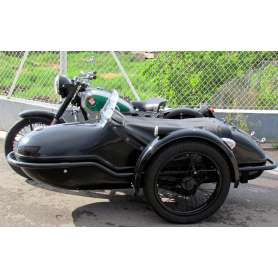No products
Prices are tax excluded
Detailed privacy of the user registry: Here
Legal notice and detailed cookies policy. By continuing to use the site, you accept our use of cookies: Find out more.
129.2
Refurbished
Classic bike with enrollment historical B. S., 600cc, G/M21, immaculate and fully restored.
In perfect state of operation, is attached a sidecar to the game. Tuition Historica. Year: 1948.
This product is no longer in stock
Warning: Last items in stock!
Availability date:

B. S. A. 600cc. G/M21.
Classic bike with enrollment historical B. S., 600cc, G/M21, immaculate and fully restored.
In perfect state of operation, is attached a sidecar to the game. Tuition Historica. Year: 1948.
Recipient :
* Required fields
or Cancel
| State | SOLD |
The BSA M-SERIES SIDEVALVES (M20 and M21) (literal Translation from the English)
were introduced in 1937 and owes its existence to the pen of such a draughting Valentine (Val) Page-the same highly-talented ex-JAP and ex-Ariel designer responsible for machines, such as the technique creditable (in case you want stylistically) Triumph 6 / 1, the redoubtable BSA Gold Star and, not least, a wide range of the very underrated single Ariel.
Discontinued in 1963 (1955 for the M20), two sizes of engine were listed by the Birmingham Small Arms Company, the 496cc M20 (82mm x 94mm), and the M21 591cc (85 mm x 105 mm, up to 1938, and 82 mm x 112 mm thereafter). Both bikes started with a change of hand, stiffer frames and forks beam. That was more or less the pre-war State-of-the-art-sidevalve.
For 1940, the feet change was normal, which adapts the british army and helped to persuade the Ministry of Defence to push the bike into the military service. The WM20, however, was not ideal for war. It was too heavy, too slow, and had the ground clearance is poor. But it was (mercy small) durable and easy to repair, that must have been a key factor in the BSA was awarded a contract to supply them in large quantities.
The cessation of hostilities, not the least of 124.334 of sidevalves most famous of Great Britain had been whipped to the military, a good part of which are still giving "service pound sterling in several remote corners of the empire.
Post-war, M20S and M21s became available again for civilian use. Although largely intended to be hacks sidecar, M20S were sold initially without the outgoing sidecar needed (probably for eating leftovers 'a-tacos "marcos military). The M21, meanwhile, was always intended primarily as a machine sidecar, therefore, the lower their friction, flywheels heavier and larger tire size rear section.
Along with these new bikes came thousands of military men given a low-mounted, that were essentially disposable machines in their day. And many owners did just that (or-according to popular folklore, in some cases, in fact, they buried in their gardens. Go figure).
Immediate post-war M20s/M21s is supplied with girder forks, probably in part to the use of military reservations. But in 1948, the telescopic forks were fitted, which required an amendment (free space) to the diagonal tube front to avoid the front fender (currently enjoying major ride) from crashing into the frame. This, in effect, means that the frames are built to fork beams are not really suitable for teles. Take note of this if you are going to buy a box of bit assorted.
A cylinder head made of alloy, intended to contribute to the correction of long-standing of the M-Series "the problem of heat dissipation, was introduced in 1949. Suspension of the plunger rear (for both models) came out in 1951 (stiffer frames, however, continue along until 1960).
To dualseat was an optional extra in 1952.
In 1956, a front brake 8-inch was introduced for the M21, while the M20 was removed from the range.
Throughout the production cycle, there were various carburettors / floating changes, including the type of camera Amal 76 (1937-38), Amal 276 (1939/45) and a 376 hereinafter monobloc from1955. However, many owners simply equipped-and still is-fit anything it worked.
In 1958, the M21-untiring, but outdated-it was listed as a machine "special order" only. However, the AA (along with similar organizations) clearly had a penchant for them, as they continued to purchase the right model (special order) until 1963, when the curtain closed forever.
In 1961, the M21 supplemented its dynamo with an alternator (bicycle AA only).
The motorcycle sidevalve last occurred in Great Britain? Not at all. The Triumph 498cc TRW (sidevalve twin) occurred until well into the 1960s for use by the government, and the 192cc Velocette LE (water-cooled sidevalve flat twin) continued until the 1970s).
No customer reviews for the moment.